July 1998 Flower Gardens Trip Report
Text and images Copyright (C) 1999 David M. Read. All rights reserved.
|
| I had the opportunity to work as a divemaster guiding dives for high
school and grade school teachers at the Flower Gardens on a three-day trip, from July 6 to
July 8. The program was organized by the Flower Garden Banks National Marine Sanctuary
office, and funded through the Gulf of Mexico Foundation, and was open to to school
teachers across the country. All told, there were over 20 teachers enrolled in the
four-day program (three days of diving, one day of classes). |
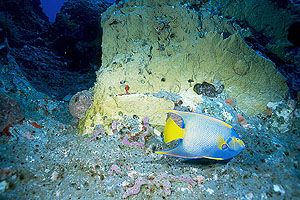
A Queen angelfish swims near a ridge of fire coral on Stetson Bank.
|
We left Freeport, Texas aboard the M/V Fling on Sunday evening, July 5th, and arrived
at the West Bank of the Flower Gardens Monday morning, where we commenced three days of
diving at 7am.
The conditions in the Gulf this year have been less than stellar, as high seas and
strong winds have caused the cancellation of almost all diving trips. We, on the other
hand, lucked into three days of flat seas (less than 3 feet the whole time, and less than
two feet for all but a few hours) and negligible currents. The water was extremely warm
for this time of year, running as high as 87F at the surface, and 83F at depth. Stetson
Bank ran a little cooler due to a thermocline at 65 feet, but the bottom still registered
78F. The scientists on board expressed some concern that the overly warm seas this year
would result in coral bleaching later in the year. [It happened! See the Labor Day '98 trip report for more details.]
Visibility was not as good as I have seen in the past, but still the worst dive
delivered approximately 50-foot vis. Plankton was clearly visible in the water, making me
wonder about the presence of a plankton bloom of some sort. The vis reached as high as 100
feet on a couple of the dives, especially early in the morning, but it tended to get worse
as the day progressed.
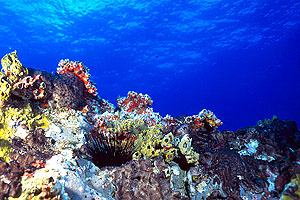
Stetson bank has more than just fire coral to see.
|
Generally, the Flower Gardens and Stetson Bank delivered the sort of
diving experiences I have come to expect from them. The fish were out in force, which was
a treat for the teachers, who were participating in the Reef Environmental Education
Foundation (REEF) Great American Fish Count. The species observed were too many to list
here, but all the usual inhabitants were visible. Creole fish, brown and blue chromis,
several species of parrotfish (stoplight, queen, princess, etc.), spanish hogfish,
yellow-lined and spotted goatfish, squirrelfish, blackbar soldierfish, bermuda chub,
yellowhead and bluehead wrasse, etc., etc. I could go on for pages. |
Here are some excerpts from my dive log. Please excuse the general scarcity of
photos for this trip report. Since I was leading dives, I didn't feel comfortable
spending a lot of time with my camera. As a result, I took only a few photos, and
most of those were taken with my Aquashot 3e.
| Dive 1: Monday, July 6, West Bank, Buoy #5. Simply a
great dive. 83F water, lots of fish, lots of fun. The most interesting thing I saw was a
huge clam nestled into a coral head. All the usual suspects: sharpnose puffers, blue &
brown chromis, barracuda, queen & stoplight parrotfish, a solitary blue tang, neon
gobies, juvenile bluehead wrasse, longsnout butterflyfish, juvenile threespot damselfish,
smooth trunkfish, etc. |
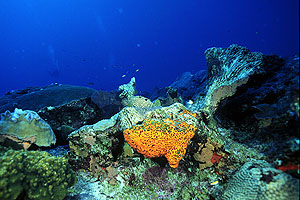
A sponge grows near a coral head at West Bank. |
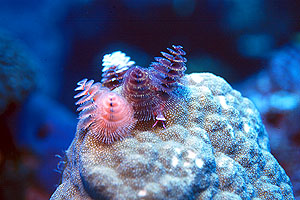
Christmas Tree Worms grow atop some star coral.
|
Dive 2: Monday, July 6, West Bank, Buoy #5. Another great
dive. Christmas Tree worms everywhere, rough file clams, and a tiny (1/4" dia.)
goldentail moray. We also saw some huge conchs, and two black durgons in what looked like
some sort of mating dance. They broke it off and fled when I approached with the camera,
of course. |
| Dive 3: Monday, July 6, East Bank Buoy #6. 1st dive at
East Bank this trip. Stayed shallower (most of dive < 65 feet) due to aggressive
profile on dive 2. East Bank has more terrain variety than west bank, with sand flats,
towering coral heads, deep coral "cavelets," and plenty of overhangs. There are
even a few holes which are almost big enough to be swim- throughs. The biggest finds on
this dive were a couple of large french angels and a giant rough fileclam under an
overhang. |
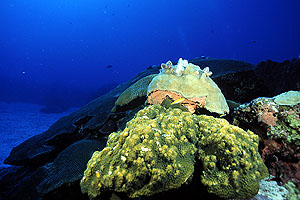
East bank offers sand flats, coral heads, and thousands of christmas-tree worms.
|
| Dive 4: Monday, July 6, East Bank Buoy #6.
Night dive! This wasn't the spectacular variety of night dive, but there were plenty of
"normal" things to see. Lots of puffers, squirrelfish, a few juvenile spotted
drum, and lots of plegaic tunicates in the water. Dive 5: Tuesday,
July 7, East Bank Buoy #3 Great early-morning dive; we hit the water while the sun was
still low on the horizon. Lots of fish out & about, and they seemed hungrier than
usual. French and Queen angels, rock beauties, a trumpetfish pretending to be a sea rod, a
few adult yellowtail damsels, smooth trunkfish, blue & brown chromis, etc. Lots of
sponges in this area, including what looked like a brown barrel sponge whose bottom had
been cut off; you could see right through the bottom of the thing. I saw three banded
cleaner shrimp in two different locations, but none of them were interested in cleaning my
hand. |
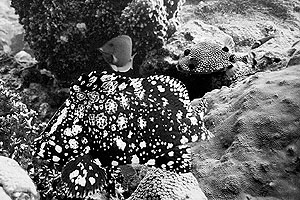
Can you imagine how hard it would be to recognize a marbled grouper as a fish if
you were color-blind?
|
Dive 6: Tuesday, July 7, East Bank Buoy #3 Better vis,
better dive. We saw a giant blackbar soldierfish (at least 12" long) hiding in a
cavelet, and our camouflaged trumpetfish again. We swam to the drop off ("wall"
is not the right word, as the coral just slopes away gently) to look for pelagic critters,
but had no luck. Played with a giant school of bermuda chub (at least 100 members) during
the safety stop. Had problems with strobes, so only natural-light (read that
as "very blue") photos. Converted this one of a marbled grouper to
black& white for fun. |
| Dive 7: Tuesday, July 7: Oil Rig HI-376A Rig
Dive! This rig was a deep-water rig, with the bottom at roughly 600 feet, so for the most
part this was a blue-water dive. Looking down, there is definitely no observable bottom,
just blue. The most exciting part of the dive was seeing a large silky shark cruising the
outside of the rig, around and around. It showed no interest in nor fear of the divers.
The fish life included another school of bermuda chub, french, queen, and townsend angels,
tesselated blennies and seaweed blennies, and juveniles of all kind. Came within inches of
getting bonked on the head with a 2-pound weight dropped by a diver inadvertently. Dive
8: Tuesday, July 8: Stetson Bank Buoy #3 Night dives at Stetson can be magical,
and this one was no exception. We started out finding a huge sea cucumber and lots of sea
urchins (spiny and pencil), along with rock hinds, squirrel- fish and dozing creole fish,
but things got more interesting as soon as we turned the corner at the wall. First up: a
large (at least 4-inch dia.) spotted moray hiding in a nook next to a crab. The we saw a
couple of tiny decorator crabs cruising the floor, another spotted moray (tiny: no more
than 1/2" dia.), a deer cowrie, and then the real fun started. Juvenile french angels
(breathtakingly beautiful), two more large morays, a large conch humping its way across
the sand, and so much more that I've already forgotten a lot of it. |
| Dive 9: Wednesday, July 9: Stetson Bank Buoy #2 More good
Stetson sights, but buoy #3 is a better dive sight. We started off finding a scorpionfih
waiting for us right at the mooring bolt, then we found another on a rock wall less than a
minute later. Finding a juvenile queen angel was the highlight of the dive. We finished
the dive by finding a small spotted moray within 20 feet of the mooring bolt. |
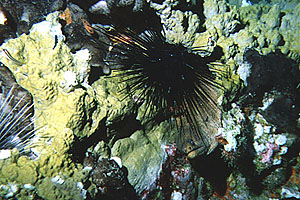
A moray eel peeks out from behind an urchin
at Stetson Bank.
|
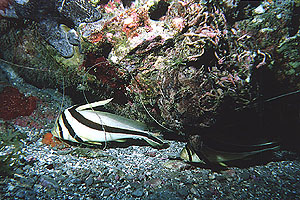
Two jack-knife fish swim beneath a coral head at Stetson. The line running
through the photo is monofilament fishing line.
|
Dive 10: Wednesday, July 9: Stetson Bank Buoy #2 the
highlight of this dive was finding two jackknife fish swimming under/around a circular
rock, with a scorpionfish on top of the rock. I tried to pick up the scorpionfish, but had
no luck. I pushed my computer to its limits, spending the last 10 minutes at the top of
the wall (65 feet), looking out to deep water. I was rewarded by a swim-by from a silky
shark and an amberjack. I spent a long (20-minute) safety stop waiting for my computer to
clear back to green, and saw lots of chub, barracuda, and several crevalle jack near the
surface. |
Dive Log Details:
| Dive # |
Location |
Depth |
Time |
Comments |
| 1 |
West Bank Buoy #5 |
82 |
0:45 |
Lots of fish, 82F water, great dive |
| 2 |
West Bank Buoy #5 |
82 |
0:42 |
Lots of christmas tree worms, rough fileclams |
| 3 |
East Bank Buoy #6 |
71 |
0:45 |
Love that East Bank terrain! |
| 4 |
East Bank Buoy #6 |
74 |
0:36 |
Night dive |
| 5 |
East Bank Buoy #3 |
80 |
0:50 |
Angelfish, rock beauties, cleaner shrimp |
| 6 |
East Bank Buoy #3 |
76 |
0:51 |
Giant soldierfish, trumpetfish |
| 7 |
Oil Rig HI-376A |
86 |
0:38 |
Shark! Also lots of juvenile fish inside the rig. |
| 8 |
Stetson Buoy #3 |
69 |
0:41 |
Night dive! Morays, crabs, deer cowries, juvy french angels, plus
more. |
| 9 |
Stetson Buoy #2 |
92 |
0:37 |
Scorpionfish, more juvy french and queen angels. |
| 10 |
Stetson Buoy #2 |
86 |
0:48 |
2 Jacknife fish, plus silk shark near the wall. |
Last modified December 28, 1998
|







